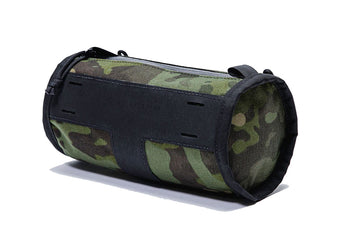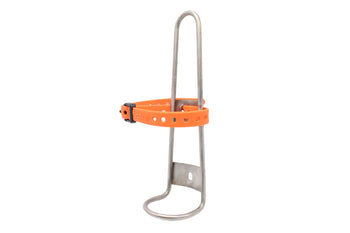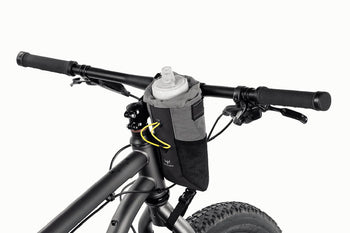
Bike-packing and bike touring are almost interchangeable terms. Bike touring setups tend to use fixings on the frame to hold pannier bags and have been the staple setup for riders since the 1930s. The beauty of bike-packing is its simplicity: most bikes can be a bike-packing bike. Thanks to the advent of soft bags in the last twenty years, bike-packing doesn’t depend on a particular frame having eyelets for racks and panniers.
Most bike-packing bag manufacturers have an ecosystem of bags. There are no hard and fast rules in bike-packing and we think that mixing your bag brands is absolutely fine in order to achieve a rig that is right for you.
We’ll outline three levels of bike-packing kits and the different trips they are designed for. Or skip to our bag explainer for what to consider when choosing your three staple bags: handlebar roll, saddle pack and frame bag.
1. The Day Out / Overnighter

This setup utilises three bags: a saddle pack, small handlebar bag, and a top tube pack. It is great if you are planning a visit to far-flung friends or family but would rather not go by car. You can stuff clothes and shoes into the saddle pack and toiletries and a rain jacket into the front bag. Access your phone, wallet, and snacks on-the-go from the top tube pack rather than weighing down your jersey pockets.
If you’re starting out and want to keep things straight forward, this layout is perfect for riding mostly on the road as it will give you the opportunity to feel how your bike rides with bags attached. Pubs, cafes and shops (usually) abound will make refuelling a breeze. In this setup we’ve avoided using a frame pack for easy access to two water bottles.
Pro Tip: pack a swimmers chamois (shammy) towel instead of a cotton towel. They absorb water super quickly, and get water than makes you cold off your skin quickly. They can be wrung out easier than an standard cotton towel. The chamois dries quicker than a towel, its lighter and packs down smaller.
2. The Weekender

Once you’ve enjoyed your first overnighter, there’s a good chance you’ll be hooked and want to take your bike-packing adventures to the next level. The charity Cycling UK (formerly the CTC) has worked to create signed circular loops that can be completed in 3–5 days and are almost car free.
This setup is ideal for their routes. We’ve added a half frame pack, which maintains space for a full water bottle on the frame. Frame packs are available in multiple sizes. Measure the interior length of your frame triangle so you can choose a bag that will fit inside. The frame pack is great for storing your heaviest items such as food and items you might want to access during the day. Up front, the handlebar bag is bigger and has straps on the front for tent poles or a compact sleeping bag.
Plan to stop at a campsite on your first weekender? This will give you the opportunity to hone your evening and morning routine as well as access showers, local shops, and fresh water.
Pro tip: try to keep handlebar pack contents light so as not to affect your steering on rough and twisty terrain.
3. Multiweek Trip

This setup uses a full frame pack and this will mean you’ll need to remove your bottle cages. We added a handlebar accessory pouch to carry your water bottle. Frame packs come in different sizes and with different strap locations. Measure the internal width of your frame and check the location of straps to ensure it won’t foul your front derailleur.
For a multi week trip you may need to carry a week’s worth of food, extra things like washing powder for clothes, and, if it's the autumn and very muddy, a couple of extra pieces of kit. Full frame packs are a great way to increase the carrying capacity of your bike.
The Condor Bivio Gravel and Odyssey Gravel framesets are both equipped with pannier rack mounts should you want the versatility of running traditional rear pannier luggage. Panniers are popular with riders who have smaller frames and struggle to fit a frame pack to their bike. Equally, narrow handlebars can restrict the size of the pack you can have on your bars.

Bike-Packing Bag Explainer
There are numerous brands making bags. Each has unique features or a certain fitting style. Here’s a quick guide what to consider when choosing your three staple bags and what our most popular brands offer.
Waterproof or water-resistant?
Most ultralight bags are water-resistant. The fabric will keep most of your kit dry in a rain shower but the seams and possibly zips are not taped. Waterproof bags have a heavier fabric and welded seams, which make the bags slightly heavier.
Ease of removal
You may not need to open your bags until you reach your destination, or you may want quick access to grab shoes, a jacket, your phone, or money. Not every bag needs to be quick to remove and you may not need constant access. Part of the enjoyment riders find in bike-packing is honing their setup.
Saddle Packs
Also known as: seat pack, saddle bag
Capacity: 5L to 14L
A lozenge-shaped bag that sticks out from underneath your saddle. The bag is attached with two large straps around the seat post and across your saddle rails. It is one of the best purchases you can make for bike-packing. Unlike panniers, a seat pack won’t catch on your legs if you need to hike or push your bike on un-rideable terrain. One criticism of a saddle pack is ‘tail wag’, where the bag swings from side to side when it is not fastened correctly, tightened enough, or the bag is loaded with heavy gear.

Brooks Scape Seat Bag
Brooks use a clamshell design for their saddle bag. The structured outer is fastened to your bike, whilst a waterproof inner bag is slotted in and can be removed without detaching the whole bag assembly.

Apidura Backcountry Saddle Pack
In 2020, Apidura updated their legendary Backcountry pack range, tweaking the geometry for off-road riding & adding abrasion-resistant fabric. The pack fits to the bike via a large Velcro strap around the post and two buckles through the saddle rails. The interior is accessed via a roll top closure.

Ortlieb Seat-Pack QR
Ultra waterproof, Ortlieb are well-known for their rugged fabric with welded seams. Seat Pack QR attaches via a Velcro strap and a bracket fitted to the rails with a quick-release feature. The bracket ensures that there is absolutely no sway or tail wag. Metal sliding buckles secure the opening. However, this near-perfect design comes with a weight penalty.
Handlebar Packs
Also known as: handlebar roll, bar bag
Capacity: 2.5L to 14L
Handlebar packs come in different shapes, sizes and fixings. The aim is to keep the contents light to reduce the impact on your steering. Keep in mind that the width of your handlebars will determine the size of the bag you use. If you have an out-front mount for a cycle computer, the bag may clash with it. Consider getting a stem mounted bracket for your Wahoo or Garmin to alleviate this.

Apidura Backcountry Handlebar Pack
The Backcountry range is for off-road riding. The pack uses an all-in-one design with two roll-top closures on either end, and built in handlebar and head tube attachment points. This means that the bag sits close to the bars, limiting grip locations on the top. This bag is designed for mountain bikers or riders who don’t need frequent access to the bag.

Ortlieb Handlebar Pack QR
The square-shaped, top-loading handlebar pack is a fully waterproof bag. Fixing is via a hardened plastic plate for tool-free mounting and there is no risk of shaking on rough ground. Reserve a little time for initial fitting and adjustment. The plate steps the bag away from the bars, leaving the handlebar tops available. Access is via the top, making access on the road easy.

Brooks Scape Handlebar Pouch
A waterproof, traditional looking handlebar roll. Fitting is by straps looped around the handlebars. Brooks provide various thicknesses of hardened foam to set the bag away from the bars to allow the rider full grip around the bar top. Its structured shape means it can't be compressed or squished into another bag.
Frame Packs
Also known as: frame bag
Capacity: 3L to 14L
Frame packs fit inside the front triangle of your bicycle frame. Frame packs are available in two main shapes; half pack and full pack. A full frame pack will fill the entire triangle but will stop you from carrying water in your bottle cages. Half frame packs use the top half of your triangle and can usually fit more gear than you’d expect, and you can usually fit a bottle cage in too.
A frame pack should fit snugly into your frame and in addition to the two shapes, manufacturers offer different sizes so you can find the right fit for your frame size. Measure the internal triangle to ensure you find the best fit for your bike, if you have a short headtube be wary of where the velcro straps are located on the bag as the front velcro strap may not fasten correctly if the tube junction is compact.
Frame packs are fitted using velcro straps and have various zips in the side for easy access. Storing food in the pack is a good idea because it is easy to reach via the zips. It can be easy to overload a frame pack because there is so much space. Be careful of putting too much pressure on the zips as a breakage will either lock you out of your bag or let the elements in.
Pro Tip: Pack heavy items that you don't need access to such as kettles, stoves and cups at the bottom of the pack, to lower the centre of gravity. Put compressable luggage like spare socks, tea bags, clothing in the void within cups and kettles to maximise the use of the space.
Discover more bike packing solutions

QUICK ADD
Mission Workshop Toro Bar Bag
 Black Friday
Black Friday
QUICK ADD
King Cage Mini Thing Cage






























